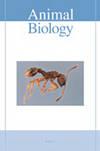溪蛙变态时质量的野外变化及其与溪流环境的关系
IF 0.9
4区 生物学
Q2 ZOOLOGY
引用次数: 1
摘要
具有复杂生命周期的动物,如两栖动物,在变形时会改变它们的栖息地。早期的变形特征(例如,变形的大小和时间)会影响成年期的生长、繁殖和生存。因此,变态特征是影响个体适应度的重要因素。尽管在野外对两栖动物变态时的大小进行了研究,但其与环境因素的关系尚不清楚。我们的目的是量化一种名为Odorana splendida的蛙类在多条溪流中变形时的质量变化,并展示这些变化与环境条件的关系。我们在11条野外溪流中寻找变质岩,并测量了它们的体型。然后,我们研究了每条溪流的环境条件与变形质量之间的关系,以揭示决定质量的因素。我们在三年内发现了229次变形。变态时的估计质量在0.17克到1.44克之间,溪流之间的变异系数为0.38。不同溪流变态时的大小存在显著差异,受水温和叶绿素a浓度的正影响,而受海拔、坡度和成虫数量的负影响。我们发现,在自然溪流内部和之间的变态过程中,O.splendida的质量变化很大。变态时较低的质量可能与溪流中稀缺的食物资源和幼虫阶段较高的竞争有关,这是由于交配成虫数量较多所致。本文章由计算机程序翻译,如有差异,请以英文原文为准。
Field variations in mass at metamorphosis in a stream frog, Odorrana splendida, and their relationship with the stream environment
Animals with complex life cycles, such as amphibians, shift their habitats when they metamorphose. Metamorphosing traits (e.g., size at, and timing of, metamorphosis) at an early stage can affect the growth, reproduction, and survival in the adult stage. Thus, metamorphosing traits are important factors that affect the fitness of the individuals. Although size at metamorphosis in the field has been investigated in amphibians, its relationship with environmental factors has been scarce. We aimed to quantify variations in the mass at metamorphosis of a stream frog, Odorrana splendida, among multiple streams, and show the relationship of these variations with environmental conditions. We searched for metamorphs in 11 field streams and measured their body size. We then examined the relationship between environmental conditions of each stream and the mass at metamorphosis to reveal the factors determining the mass. We found 229 metamorphs over three years. The estimated mass at metamorphosis ranged from 0.17 g to 1.44 g, with a coefficient of variation among streams of 0.38. The size at metamorphosis significantly differed among streams, and was found to be positively affected by water temperature and chlorophyll a concentration, and negatively affected by altitude, slope gradient, and the number of adult calls. We showed that O. splendida has a large variation in mass at metamorphosis within and among natural streams. A lower mass at metamorphosis may correlate with scarce food resources in the stream and higher competition during the larval stages, resulting from a higher number of mating adults.
求助全文
通过发布文献求助,成功后即可免费获取论文全文。
去求助
来源期刊

Animal Biology
生物-动物学
CiteScore
2.10
自引率
0.00%
发文量
34
审稿时长
3 months
期刊介绍:
Animal Biology publishes high quality papers and focuses on integration of the various disciplines within the broad field of zoology. These disciplines include behaviour, developmental biology, ecology, endocrinology, evolutionary biology, genomics, morphology, neurobiology, physiology, systematics and theoretical biology. Purely descriptive papers will not be considered for publication.
Animal Biology is the official journal of the Royal Dutch Zoological Society since its foundation in 1872. The journal was initially called Archives Néerlandaises de Zoologie, which was changed in 1952 to Netherlands Journal of Zoology, the current name was established in 2003.
 求助内容:
求助内容: 应助结果提醒方式:
应助结果提醒方式:


